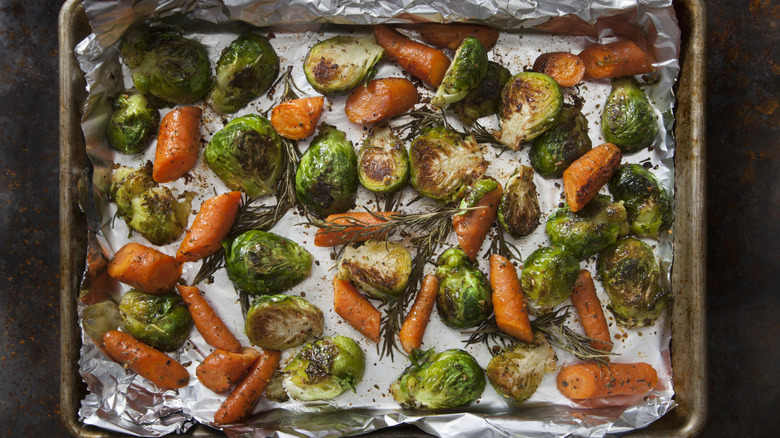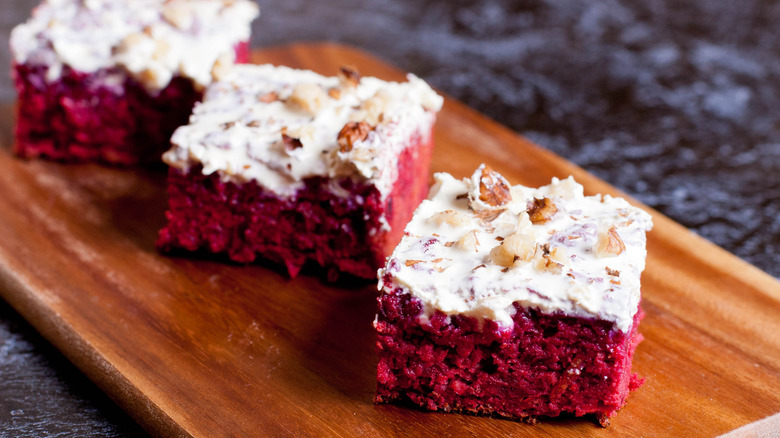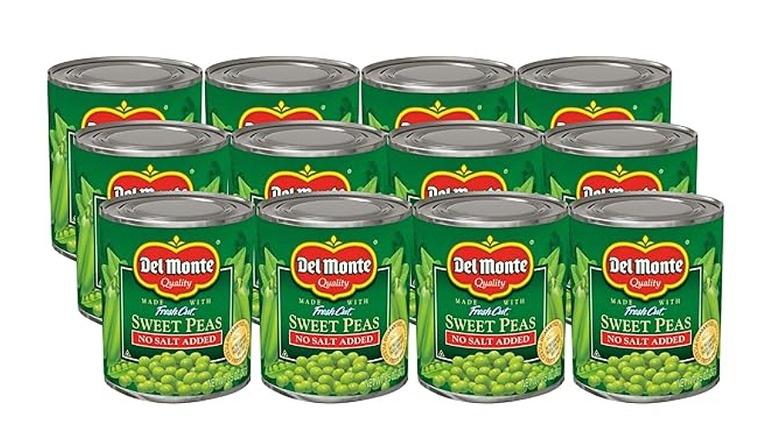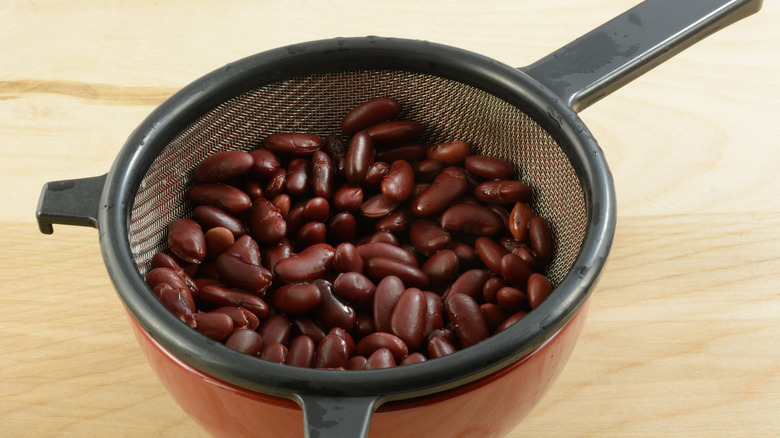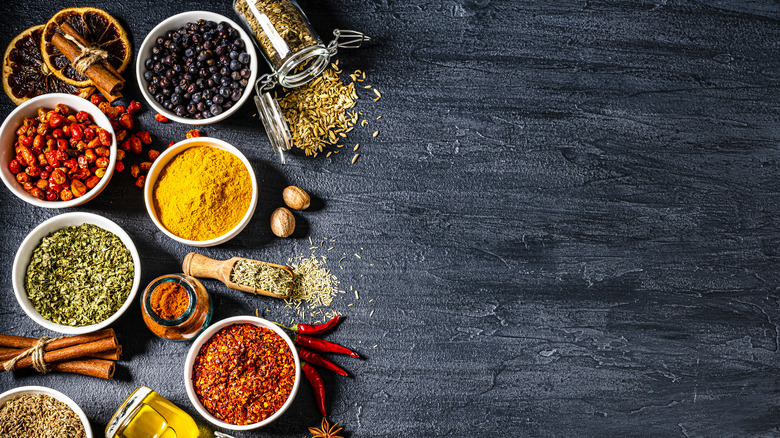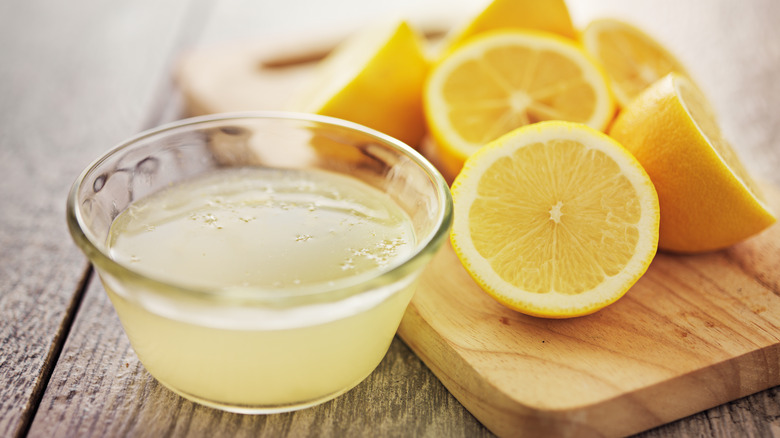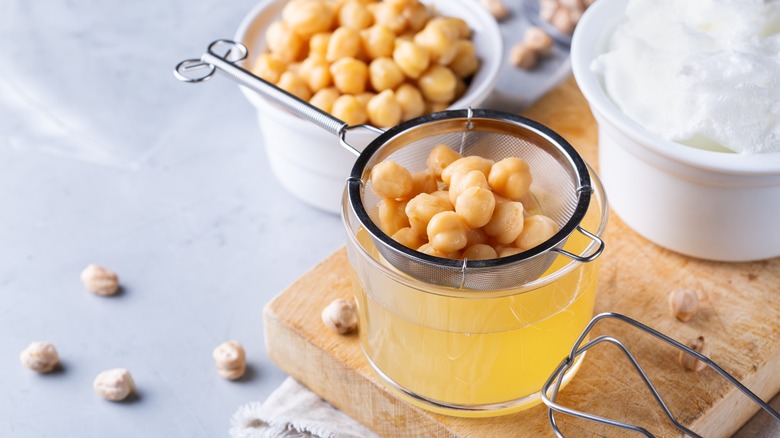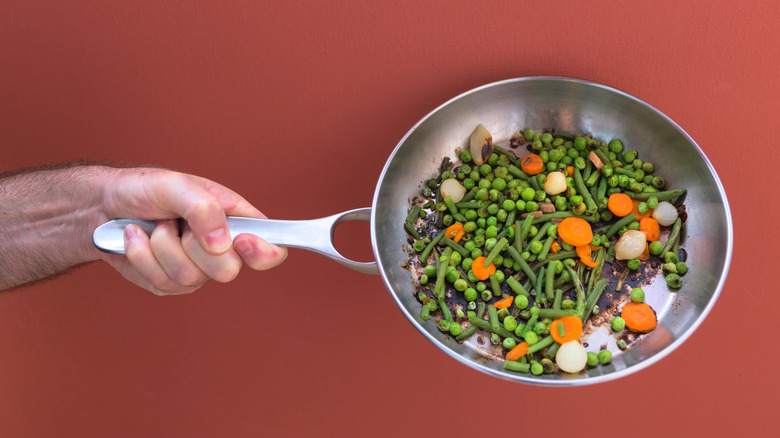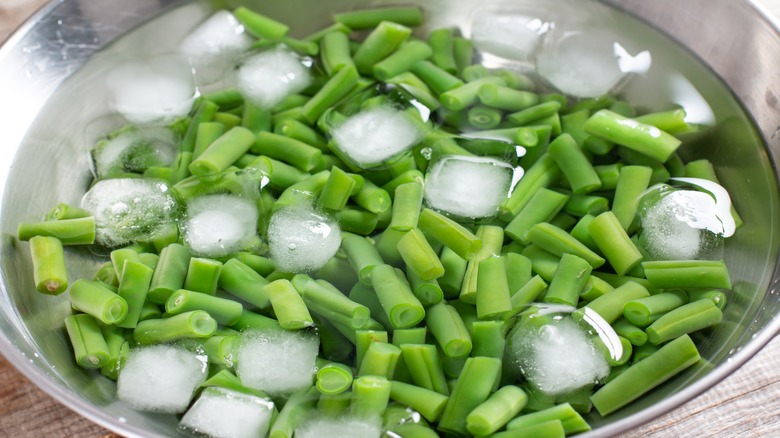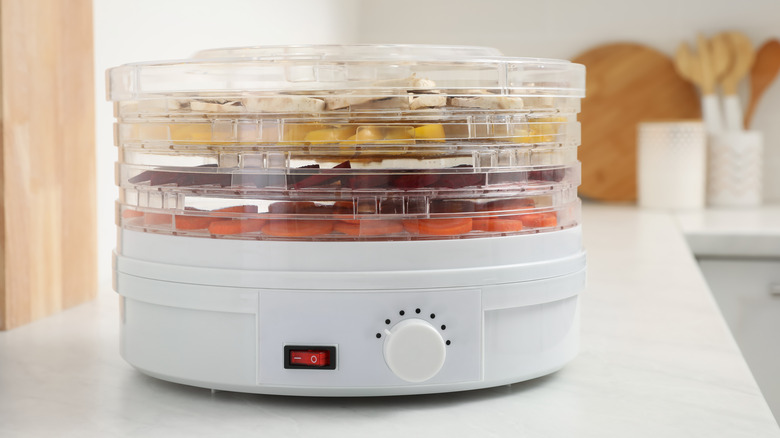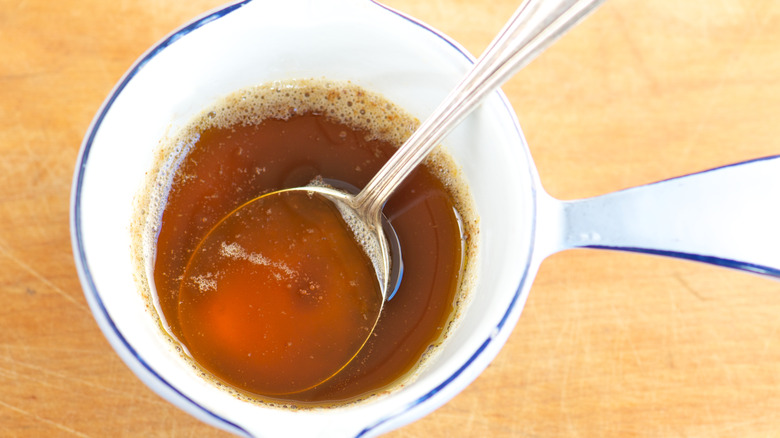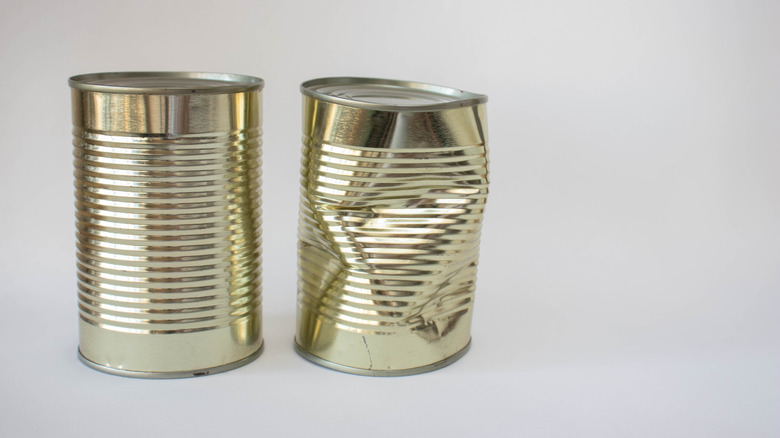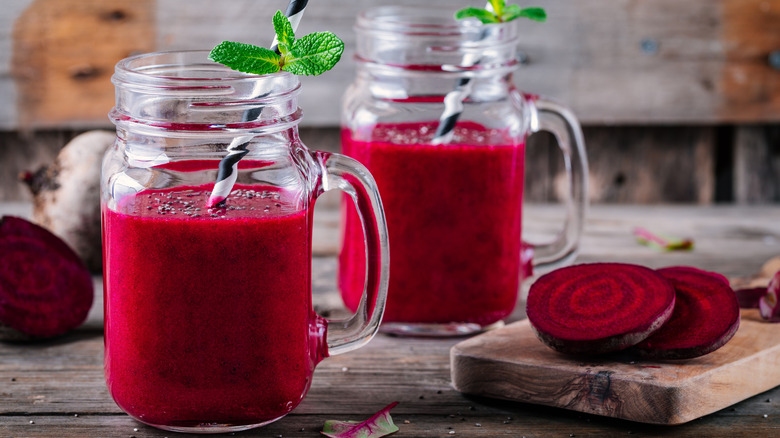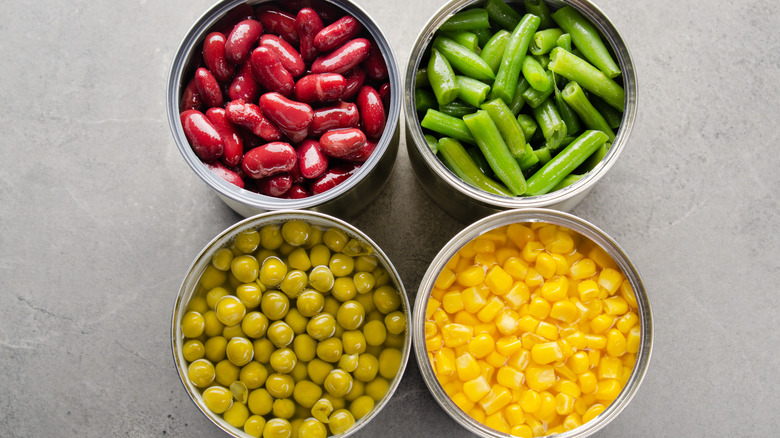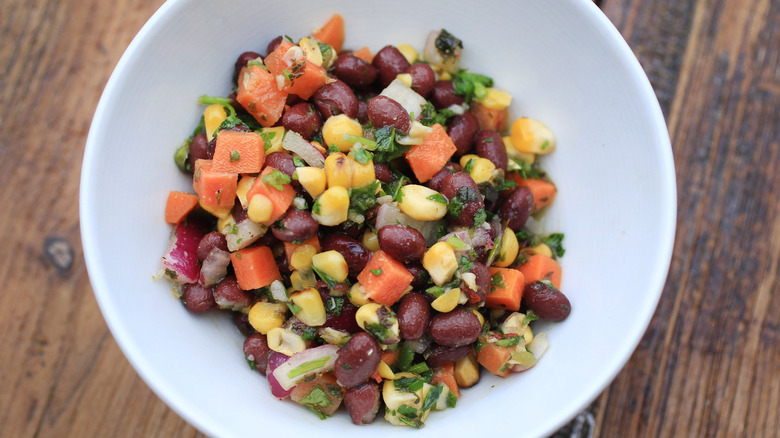Chef Highlights The Big Mistakes You're Making With Canned Vegetables
To eat or not to eat? That has long been the question with canned vegetables. Concerns over sodium levels, safety, and quality have often been raised, confusing consumers. The fact is that canned vegetables are an affordable, convenient way of obtaining essential nutrients and can be a quick and easy means of adding flavor to many dishes. The vegetables themselves are harvested and processed at peak freshness, have a long shelf-life, and will not spoil if safely stored during a disaster or power outage. The key to using them is knowing what mistakes to avoid to obtain maximum nutritional benefit and flavor. That's where I come in.
As a chef with nearly 18 years of professional experience, canned vegetables have played an integral role in many of my favorite recipes for as long as I can remember. Regardless of which canned vegetables you buy and use, some key strategies will help you avoid many of the pitfalls associated with eating and cooking them, such as knowing which ones to rinse and pre-cook versus those you should add at the very end of the cooking process. Avoid these canned food mistakes to get the most bang for your buck in both the taste and health departments, allowing you to incorporate them into your daily culinary rituals with ease.
1. Mistake: Neglecting to roast them
There's no way canned vegetables can compare to fresh in some recipes; they tend to suffer in the texture department, becoming mushy and soggy from the brining and canning process. This can be a real turn-off for some who are particularly sensitive to textures, and it does make a difference even in cooked recipes, particularly with vegetables that I prefer to eat more on the al dente side, like green beans and carrots.
The simple solution for reviving these waterlogged canned vegetables is to toss them in the oven. Roasting canned vegetables will help eliminate excess moisture and add a hint of color and flavor. I recommend draining, rinsing, and thoroughly drying them before you season and roast them, as excess moisture can prevent the Maillard reaction from happening during cooking. You should also roast similar sized and textured vegetables together so that they cook evenly. Lastly, I suggest roasting at a relatively high temperature (around 425 degrees F) and stirring your vegetables often to avoid burning them. Once they are roasted, use them in any recipe as needed.
2. Mistake: Only using them in savory recipes
There has always been a heated debate regarding whether tomatoes are a fruit or vegetable. For the sake of this discussion, we will go with the 1893 Supreme Court legal ruling versus the botanical classification that it is a vegetable. That said, this debate highlights the versatility of many vegetables when incorporating them into recipes. They can easily be added to savory and sweet recipes equally effectively.
One example is cake recipes that call for canned beets to help moisten and amplify the sweetness of ingredients like chocolate, a tradition that likely grew out of World War II and the era of rationing. Others have discovered that canned black beans can effectively mimic flour in the texture of a gluten-free cake. And if you want to elevate a souffle, add puréed canned sweet corn for textural complexity and flavor. When using canned vegetables for desserts and baked goods, you are only limited by your creativity and the inherent flavor profile the vegetable you choose.
3. Mistake: Not purchasing low-sodium options
One of the most common criticisms of canned vegetables is that they're high in sodium. Though sodium is a vital nutrient for human survival, in excess, it can pose many health risks. Unfortunately, it is also an integral ingredient in food preservation, including cured meats and canning vegetables. For this reason, selecting processed foods with less than 20% DV (Daily Value) per serving is crucial.
This is where purchasing low-sodium or no-added-salt options for canned vegetables makes good health sense. Many of the most popular brands and types of vegetables have one or more of these options available, making it easier to choose the best one for your culinary and nutritional needs.
The key is understanding what these distinctions mean. Low-sodium products are mandated to contain 140 milligrams of sodium or less per serving. While salt is not supplemented in no-added-salt varieties, this does not mean the product is devoid of sodium. Reading the labels and comparing your options is always recommended.
4. Mistake: Forgetting to drain and rinse them
Another way to address the issue of excess sodium in canned vegetables is to drain and rinse the canning liquid before using them. According to The University of Maine, doing so can reduce the amount of sodium by 36-41%. A marked improvement. The best way to drain and rinse your canned vegetables is to empty the contents into a colander or fine mesh sieve and run cold water over them. Allow the vegetables to drain thoroughly before using them so they don't water down the recipe you add them to.
One exception to this recommendation is draining canned tomatoes. If you drain canned tomatoes, you are eliminating much-needed flavor and valuable nutrients. As you cook canned tomatoes, these juices will concentrate, conferring umami-rich notes integral to building complexity in your favorite marinara or bisque. Even if you use canned tomatoes for salsa or a salad, reserve that drained canning liquid to help bolster flavor in soup, stew, or sauce recipes. If you're concerned about salt content, purchase low-sodium or no-salt-added canned tomatoes.
5. Mistake: Failing to season them adequately
Beyond texture, canned vegetables can also suffer in the flavor department, though this varies from one type to another. Certain vegetables fare better in retaining their flavor than others, such as corn, and others seem to lose the inherent sweetness and earthiness they may have had when harvested. There's also the issue of canned vegetables absorbing a tinny flavor from the can. Even after you drain and rinse your vegetables, they may retain an unappetizing element of this metallic aftertaste.
For this reason, seasoning your canned vegetables is vital, but think beyond the salt and pepper shakers. These are necessary, but you should also look at amping up flavor with other dried herbs and ground spices. Spice blends are a great way to integrate complexity and nuance into pallid produce. I'm particularly fond of Moroccan ras el hanout, different types of curry mix, and Latin blends rife with chilis and smoky cumin. Don't forget to layer flavors with aromatics, like onions and garlic. Lastly, finish dishes with fresh herbs for a verdant brightness that can revive even the dullest vegetable.
6. Mistake: Skipping the acid
Adding an acid to canned vegetables is not exactly a novel idea. According to the University of Illinois at Urbana-Champaign College of Agricultural, Consumer & Environmental Sciences, do-it-yourselfers are urged to incorporate vinegar with a 5% acidity level to their home canned goods to help prevent the proliferation of pathogens. While this is sound advice, that's not exactly what I mean here. In this case, I advise adding something acidic to store-bought canned goods to help brighten their flavor and minimize some of that metallic flavor.
Good options when using canned vegetables are lemon or other citrus juices, different types of vinegar, including apple cider or various flavored iterations, or tossing in a fermented item, like kimchi, pickles, or kombucha. This acidity will activate your salivary glands, amplifying flavor and producing greater satiety. It will also help to accentuate other flavors, like sweet and salty, by contrasting them, thereby giving your taste buds a more pleasurable experience.
7. Mistake: Tossing the liquid from drained beans
When it comes to canned beans, you will want to reserve the drained liquid from the can rather than discard it. This utilitarian liquid gold is known as aquafaba, and it can become a new secret weapon in the kitchen that you didn't know you needed. Aquafaba has become a trendy ingredient of late, featuring in countless recipes from vegan baked goods to a dairy-free alternative for whipped cream. If you're not vegan or don't require a dairy-free diet, it can still be a great tool to add to your culinary arsenal.
Because it's naturally starchy, aquafaba can be used as a thickener for soups and sauces. It has a relatively neutral flavor, is gluten-free, and doesn't clump up, making it easier to add than a roux or cornstarch. It can also be used in place of oil to create a lighter salad dressing that blends beautifully because of its emulsifying qualities. Another place aquafaba shines is when swapping it for eggs in pasta recipes, where its starchiness acts as a natural binder, pulling the flour and water together. Lastly, if you're making homemade hummus, you can thin the texture of the dip out and give it a velvety mouthfeel by incorporating some of this beany liquid.
8. Mistake: Overcooking them
As I mentioned before, many canned vegetables lose structural integrity in the canning process, making them softer and less vibrant. This means they need far less time on heat to be cooked. Overcooking them can deteriorate them, dissolving them and rendering them inedible. For this reason, I often add canned vegetables to a recipe toward the end of the cooking process.
This is particularly true when making a soup or stew using my slow cooker. Most recipes for the slow cooker will spend hours being exposed to heat. When that recipe is done, those canned vegetables will be toast if added toward the beginning of the cooking process. Add your canned vegetables to your slow-cooker recipes around the last 30 minutes of cooking for best results.
Remember too, that canned vegetables do not need to be cooked. They're canned ready-to-eat and incorporated directly into salads or other raw applications. While you can use them as-is in things like a three-bean salad, don't forget that roasting hack. Roasted, canned vegetables are marvelous when added to salads or bowls of all kinds.
9. Mistake: Not blanching them
If you want to use canned vegetables raw in salads and are concerned about that lingering metallic flavor overtaking the dish, you can mitigate this. Blanching canned vegetables is the solution for ridding them of that tinny quality. It's a simple process that involves boiling vegetables in water for two minutes before transferring them to an ice-water bath to halt the cooking process.
This last part is crucial, particularly with canned vegetables. As noted, we do not want to overcook canned vegetables and make them even mushier. You just want to eradicate that canned flavor. That's why it's necessary not to leave them in the boiling water for too long and to put them swiftly in ice water.
Before you blanch your canned vegetables, drain and rinse them. To process multiple batches of different canned vegetables, I recommend swapping out the ice water periodically to ensure it remains cold enough and doesn't contain any small floating bits of vegetables. Once blanched, strain the vegetables in a colander or fine mesh sieve to dry them out before using them in a recipe.
10. Mistake: Forgetting you can dehydrate them
If you're wondering what else you can do with your canned vegetables to transform them into something exciting and nutritious, look no further than your dehydrator. Dehydrating canned vegetables can produce a quick, on-the-go snack that tastes delicious and has abundant vitamins and minerals. As a bonus, you don't have to process canned vegetables like fresh ones by blanching them before adding them to your dehydrator. Drain, rinse, and allow canned vegetables to dry in a colander or fine mesh sieve before adding them to your dehydrator for 6-12 hours, depending on the size of the vegetable, and you are done.
For those who don't own a dehydrator, all is not lost. You can dehydrate canned vegetables in your oven. You'll want to set your oven to warm and place your vegetables onto a baking sheet lined with parchment paper. Rotate the pan and stir the vegetables periodically to guarantee that they dehydrate evenly. Once dehydrated using either method, allow the vegetables to cool completely before packing them in an airtight container or resealable plastic bag for storage.
11. Mistake: Being stingy with adding fat
You may have heard the adage "fat equals flavor" when it comes to cooking. While this may contradict current dietary recommendations suggesting we should moderate the amount of saturated fat in our diets, it makes some scientific sense with how we taste food. Not only does fat contribute to the mouthfeel, spreading flavor across our tongues and improving the overall texture of what we are eating, but it may also stimulate our taste buds, improving satiety. This is good news for canned vegetables that could use both a boost in flavor and texture.
The key is what kind of fat you choose and using some restraint when incorporating it. More is not always better in this case. I prefer to use a smaller amount of more potent-flavored fat than a ton. An herb or truffle-infused, earthy, floral olive or toasted sesame oil can be transformative. Another favorite is a perfectly made brown butter, which utilizes the Maillard reaction to consolidate the natural sugars and protein in butter to create a nutty, golden delight you can use to coat your favorite canned vegetables.
12. Mistake: Using damaged cans
We all know that food waste is a problem. Even those who cook frequently will inevitably discover a wilted science experiment at the bottom of the refrigerator that used to be a cucumber or zucchini. That is why so many people prefer to keep canned vegetables on hand rather than buying fresh. I have often seen damaged cans on clearance in stores, which may seem like a dynamite deal but may also be a disaster waiting to happen, depending on the condition of the can.
Cans that are deeply dented, leaking, or bulging can harbor one of the most dangerous toxins known, in Clostridium botulinum. Though uncommon, ingesting even small amounts of this anaerobic bacteria can be fatal, and there is no surefire way to detect it. While botulism can be neutralized with heat, if you plan to use canned vegetables raw in a salad or to make a dip, you should skip cans with a dent you can fit your finger into or along the tops or seams of the container. I generally avoid cans with dents out of an abundance of caution.
13. Mistake: Discarding beet juice
This may seem random, but pickled beets were a staple in my home growing up and have become a secret weapon in my kitchen as a professional chef. Beet juice can be used in many recipes that need a boost of acidity and a hint of saltiness. It's perfect in braised red cabbage recipes, coleslaw made from red cabbage, and indispensable in some soup recipes like borscht. It can also confer color and flavor in dips, including hummus and whipped feta with Greek yogurt.
Don't stop there though. Beet juice is a natural food dye that can color hard-boiled eggs, potatoes, pasta, and more. Additionally, it's purported to have many health benefits, even when sourced from a can, including anti-inflammatory and antioxidant properties. It is also a good source of fiber, nitrates, and potassium, making it helpful for those recovering after an intense workout. When using it in recipes, if you notice the beet juice is too earthy or acidic, balance these flavors with a hint of honey or sugar to temper it.
14. Mistake: Storing leftovers in the can
While the USDA states that storing canned vegetables in their original can after opening them is safe, you might want to avoid doing so for several reasons. First, there is some concern that foods with a lower PH, like tomatoes and pickled beets, may run the risk of some of the metal from the can seeping into them. While this is not likely to make you sick, it can alter the flavor of the food, amplifying that metallic taste that makes canned foods undesirable to sensitive palates in the first place.
A more important consideration is freshness. Cans are not easily sealed once opened, meaning they can easily take on the aromas of everything else in the refrigerator and quickly become dehydrated, affecting their texture adversely. The best protocol to follow for best quality when you only use half a can of beans or corn for a dip or salad is to transfer the remaining contents into an airtight container or plastic baggie, after which you should use the remaining vegetables within four days.
15. Mistake: Not combining fresh vegetables with canned ones
There's nothing wrong with using only canned vegetables in a soup or stew, especially when fresh ones are scarce and you happen not to have any on hand, but still want to make something healthy and filling for a hungry family. Combining the two, however, can amplify the complexity of flavor, improve overall texture, and maximize the nutritional benefit of a dish. Even when you cook fresh vegetables, they tend to have a brighter flavor and more robust texture if you don't overcook them, compared with canned. This is especially true in recipes like a hearty minestrone or chili.
Additionally, water-soluble vitamins are often lost during the canning process. Vitamin C and all B-complex vitamins are water-soluble, meaning they dissolve in water. Since canning involves cooking and processing vegetables in water, these vitamins tend to leach out. The solution is to pair raw, fresh veggies with these canned ones in your salads, salsas, or any other recipe you don't plan to cook, to increase the uptake of these water-soluble nutrients in your body.

